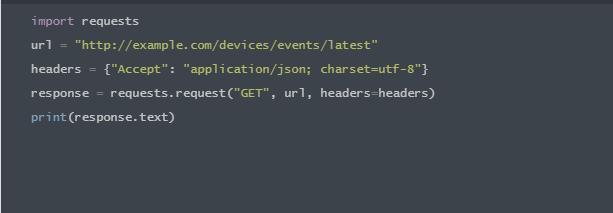Devices data can be retrieved in multiple ways. A user can retrieve a specific device, search for multiple devices at once, retrieve ID reports from a device, or get specification information regarding the device itself. All of these requests follow standard HTTP protocols, and the authentication cookie retrieved upon logging into the service must be passed in the header.
Any API GET calls can have either an empty or a nonexistent payload, whereas any PUT or POST API calls must pass a payload containing the information as called out in the examples.
A GET request example written in Python retrieving a specific device based upon its device ID is shown below. The ID of the device is passed inside of the URL, with the authentication token passed in the headers. Since this is a GET request, the payload can be empty.

An example GET request to retrieve the most recent reports based on the ESN of the devices is shown below.

To search the platform for a list of multiple devices, a POST request is sent to the platform, which must pass a payload. The headers are the same, and the URL contains the parameters regarding the boundaries of the search. This call must have a payload that contains the filled-out body of the search, as shown in the example below.

